Serving 555 students in grades 6-8, I.s. 181 Pablo Casals ranks in the bottom 50% of all schools in New York for overall test scores (math proficiency is bottom 50%, and reading proficiency is bottom 50%).
The percentage of students achieving proficiency in math is 26% (which is lower than the New York state average of 46%). The percentage of students achieving proficiency in reading/language arts is 59% (which is higher than the New York state average of 49%).
The student:teacher ratio of 10:1 is lower than the New York state level of 11:1.
Minority enrollment is 97% of the student body (majority Black), which is higher than the New York state average of 60% (majority Hispanic and Black).
Quick Stats (2025)
- Grades: 6-8
- Enrollment: 555 students
- Student:Teacher Ratio: 10:1
- Minority Enrollment: 97%
- Overall Testing Rank: Bottom 50% in NY
- Math Proficiency: 26% (Btm 50%)
- Reading Proficiency: 59% (Top 30%)
- Science Proficiency: 48% (Btm 50%)
- Source: National Center for Education Statistics (NCES), NY Dept. of Education
School Overview
I.s. 181 Pablo Casals's student population of 555 students has declined by 37% over five school years.
The teacher population of 53 teachers has declined by 15% over five school years.
Grades Offered
Grades 6-8
(offers virtual instruction)
(offers virtual instruction)
Total Students
555 students
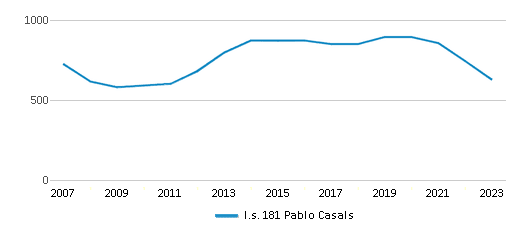
Gender %
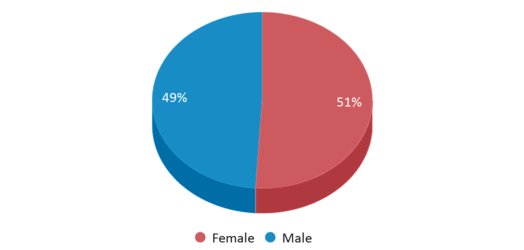
Total Classroom Teachers
53 teachers
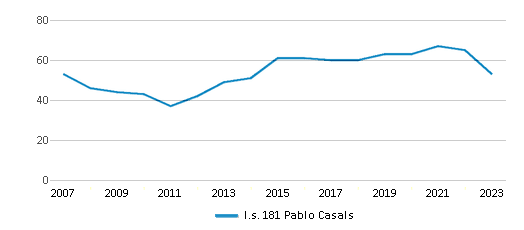
Students by Grade
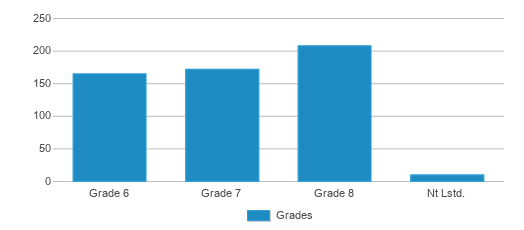
School Rankings
I.s. 181 Pablo Casals ranks within the bottom 50% of all 4,377 schools in New York (based off of combined math and reading proficiency testing data).
The diversity score of I.s. 181 Pablo Casals is 0.62, which is less than the diversity score at state average of 0.72. The school's diversity has stayed relatively flat over five school years.
Overall Testing Rank
#2397 out of 4377 schools
(Bottom 50%)
(Bottom 50%)
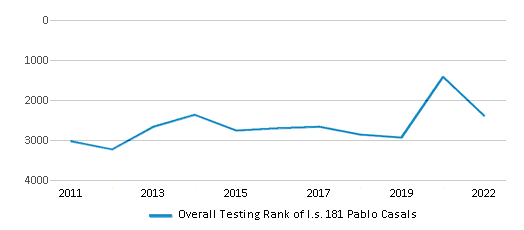
Math Test Scores (% Proficient)
26%
46%
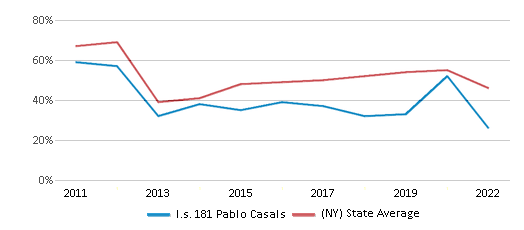
Reading/Language Arts Test Scores (% Proficient)
59%
49%
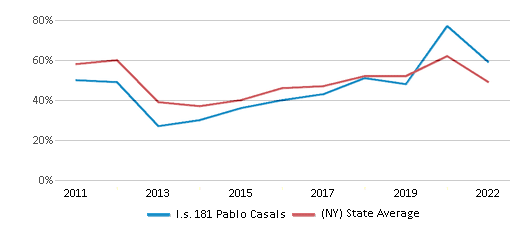
Science Test Scores (% Proficient)
48%
78%
Student : Teacher Ratio
10:1
11:1
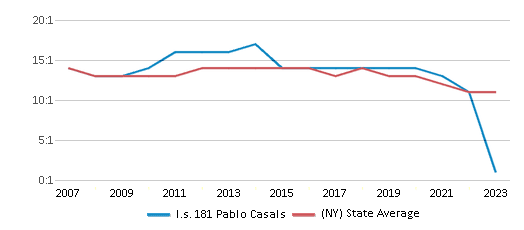
American Indian
2%
1%
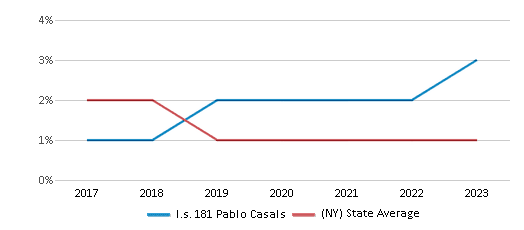
Asian
9%
10%
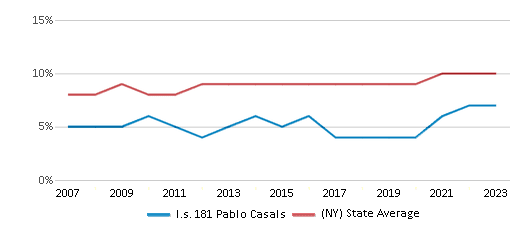
Hispanic
31%
30%
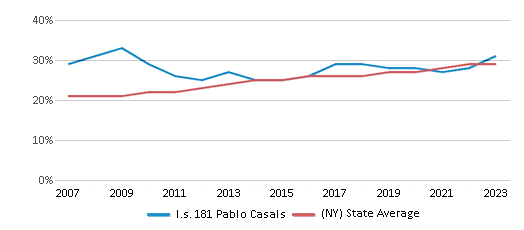
Black
53%
16%
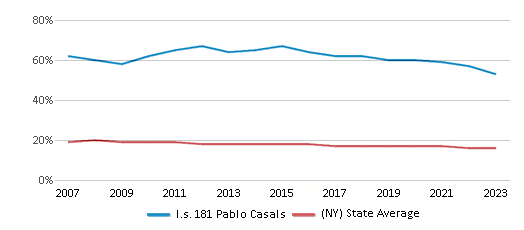
White
3%
40%
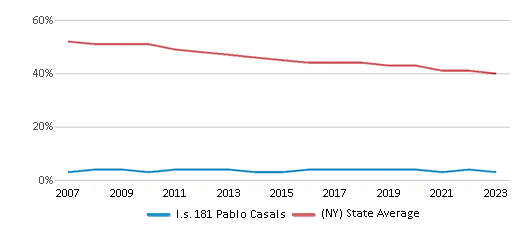
Hawaiian
1%
n/a
Two or more races
1%
3%
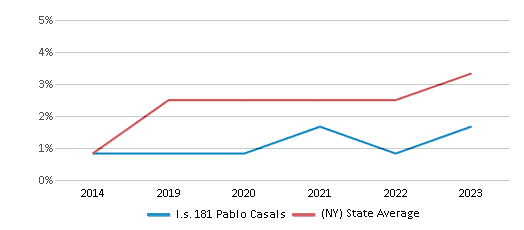
All Ethnic Groups
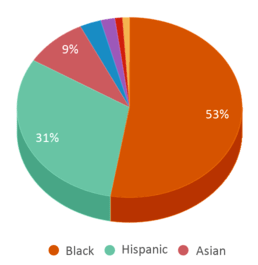
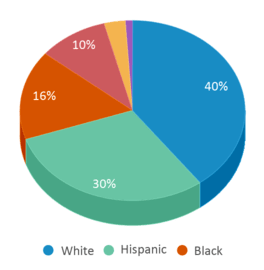
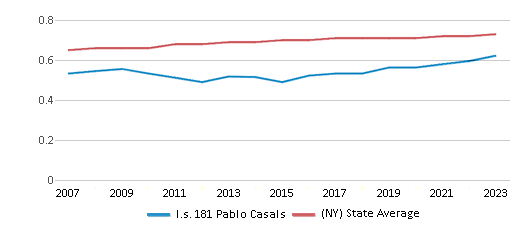
Participates in the National School Lunch Program (NSLP)
Yes
Eligible for Free Lunch
76%
54%
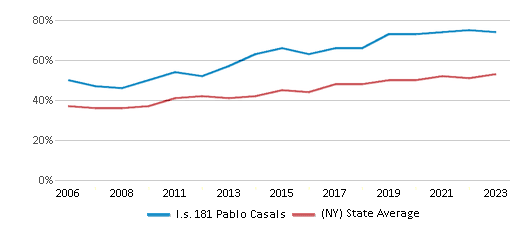
Eligible for Reduced Lunch
4%
3%
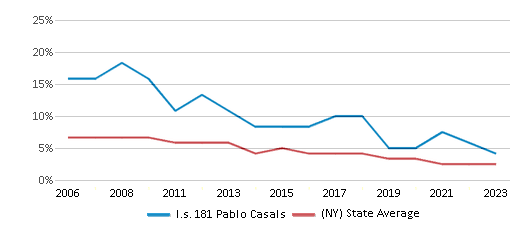
School Statewide Testing
School District Name
Source: National Center for Education Statistics (NCES), NY Dept. of Education
Profile last updated: 02/09/2025
Frequently Asked Questions
What is I.s. 181 Pablo Casals's ranking?
I.s. 181 Pablo Casals is ranked #2397 out of 4,377 schools, which ranks it among the bottom 50% of public schools in New York.
What schools are I.s. 181 Pablo Casals often compared to?
I.s. 181 Pablo Casalsis often viewed alongside schools like Middle School 180 Dr Daniel Hale Williams by visitors of our site.
What percent of students have achieved state testing proficiency in math and reading?
26% of students have achieved math proficiency (compared to the 46% NY state average), while 59% of students have achieved reading proficiency (compared to the 49% NY state average).
How many students attend I.s. 181 Pablo Casals?
555 students attend I.s. 181 Pablo Casals.
What is the racial composition of the student body?
53% of I.s. 181 Pablo Casals students are Black, 31% of students are Hispanic, 9% of students are Asian, 3% of students are White, 2% of students are American Indian, 1% of students are Hawaiian, and 1% of students are Two or more races.
What is the student:teacher ratio of I.s. 181 Pablo Casals?
I.s. 181 Pablo Casals has a student ration of 10:1, which is lower than the New York state average of 11:1.
What grades does I.s. 181 Pablo Casals offer ?
I.s. 181 Pablo Casals offers enrollment in grades 6-8 (offers virtual instruction).
What school district is I.s. 181 Pablo Casals part of?
I.s. 181 Pablo Casals is part of New York City Geographic District #11 School District.
In what neighborhood is I.s. 181 Pablo Casals located?
I.s. 181 Pablo Casals is located in the East Bronx neighborhood of Bronx, NY. There are 77 other public schools located in East Bronx.
School Reviews
5 1/20/2021
the school has amazing learning resources.
1 3/26/2020
My daughter currently attends, and I am so disappointed. There is extensive bullying, favoritism by teachers giving students grades they did not work for in 6th grade classes. A Dean that does nothing. The teachers here call parents for sport. They don't try to solve problems when they occur.
2 3/16/2020
The teachers and staff are exceptional but the higher uppers.. Principal and vice principal like to hide truths cover-up and take sides in altercations. MS. Hudson is the best, so is MS. Dante and MS Stevens. I'm glad my son it's graduating. There is a lot of preference, though. If I could do it again, my child would not go there.
3 3/16/2017
Despite drops in several areas, the school seems to be holding its own., especially with a Principal in charge for 10 years. That shows stability.
Review I.s. 181 Pablo Casals. Reviews should be a few sentences in length. Please include any comments on:
- Quality of academic programs, teachers, and facilities
- Availability of music, art, sports and other extracurricular activities
Recent Articles

What Is A Charter School?
Explore the world of charter schools in this comprehensive guide. Learn about their history, how they operate, and the pros and cons of this educational innovation. Discover key facts about charter schools, including admission policies, demographics, and funding, as well as what to look for when considering a charter school for your child.

10 Reasons Why High School Sports Benefit Students
Discover the 10 compelling reasons why high school sports are beneficial for students. This comprehensive article explores how athletics enhance academic performance, foster personal growth, and develop crucial life skills. From improved fitness and time management to leadership development and community representation, learn why participating in high school sports can be a game-changer for students' overall success and well-being.

February 05, 2025
Understanding the U.S. Department of Education: Structure, Impact, and EvolutionWe explore how the Department of Education shapes American education, from its cabinet-level leadership to its impact on millions of students, written for general audiences seeking clarity on this vital institution.





